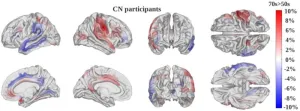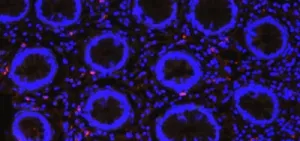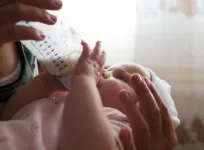(Press-News.org) A new artificial intelligence model measures how fast a patient’s brain is aging and could be a powerful new tool for understanding, preventing and treating cognitive decline and dementia, according to USC researchers.
The first-of-its-kind tool can non-invasively track the pace of brain changes by analyzing magnetic resonance imaging (MRI) scans. Faster brain aging closely correlates with a higher risk of cognitive impairment, said Andrei Irimia, associate professor of gerontology, biomedical engineering, quantitative & computational biology and neuroscience at the USC Leonard Davis School of Gerontology and visiting associate professor of psychological medicine at King’s College London.
“This is a novel measurement that could change the way we track brain health both in the research lab and in the clinic,” he said. “Knowing how fast one’s brain is aging can be powerful.”
Irimia is the senior author of the study that describes the new model and its predictive power; the study was published February 24, 2025 in Proceedings of the National Academy of Sciences.
Biological brain age versus chronological age
Biological age is distinct from an individual’s chronological age, Irimia said. Two people who are the same age based on their birthdate can have very different biological ages due to how well their body is functioning and how “old” the body’s tissues appear to be at a cellular level.
Some common measures of biological age use blood samples to measure epigenetic aging and DNA methylation, which influences the roles of genes in the cell. However, measuring biological age from blood samples is a poor strategy for measuring the brain’s age, Irimia explained. The barrier between the brain and the bloodstream prevents blood cells from crossing into the brain, such that a blood sample from one’s arm does not directly reflect methylation and other aging-related processes in the brain. Conversely, taking a sample directly from a patient’s brain is a much more invasive procedure, making it unfeasible to measure DNA methylation and other aspects of brain aging directly from living human brain cells.
Previous research by Irimia and colleagues highlighted the potential of MRI scans to non-invasively measure the biological age of the brain. The earlier model used AI analysis to compare a patient’s brain anatomy to data compiled from the MRI scans of thousands of people of various ages and cognitive health outcomes.
However, the cross-sectional nature of analyzing one MRI scan to estimate brain age had major limitations, he said. While the previous model could, for instance, tell if a patient’s brain was ten years “older” than their calendar age, it couldn’t provide info on whether that additional aging occurred earlier or later in their life, nor could it indicate whether brain aging was speeding up.
A more accurate picture of brain aging
A newly developed three-dimensional convolutional neural network (3D-CNN) offers a more precise way to measure how the brain ages over time. Created in collaboration with Paul Bogdan, associate professor of electrical and computer engineering and holder of the Jack Munushian Early Career Chair at the USC Viterbi School of Engineering, the model was trained and validated on more than 3,000 MRI scans of cognitively normal adults.
Unlike traditional cross-sectional approaches, which estimate brain age from one scan at a single time point, this longitudinal method compares baseline and follow-up MRI scans from the same individual. As a result, it more accurately pinpoints neuroanatomic changes tied to accelerated or decelerated aging. The 3D-CNN also generates interpretable “saliency maps,” which indicate the specific brain regions that are most important for determining the pace of aging, Bogdan said.
When applied to a group of 104 cognitively healthy adults and 140 Alzheimer’s disease patients, the new model’s calculations of brain aging speed closely correlated with changes in cognitive function tests given at both time points.
“The alignment of these measures with cognitive test results indicates that the framework may serve as an early biomarker of neurocognitive decline,” Bogdan said. “Moreover, it demonstrates its applicability in both cognitively normal individuals and those with cognitive impairment.”
He added that the model has the potential to better characterize both healthy aging and disease trajectories, and its predictive power could one day be applied to assessing which treatments would be more effective based on individual characteristics.
“Rates of brain aging are correlated significantly with changes in cognitive function,” Irimia said. “So, if you have a high rate of brain aging, you're more likely to have a high rate of degradation in cognitive function, including memory, executive speed, executive function, and processing speed. It's not only an anatomic measure; the changes we see in the anatomy are associated with changes we see in the cognition of these individuals.”
Looking ahead
In the study, Irimia and coauthors also note how the new model was able to distinguish different rates of aging across various regions of the brain. Delving into these differences –including how they vary based on genetics, environment, and lifestyle factors – could provide insight into how different pathologies develop in the brain, Irimia said.
The study also demonstrated that the pace of brain aging in certain regions differed between the sexes, which might shed light onto why men and women face different risks for neurodegenerative disorders, including Alzheimer’s, he added.
Irimia said he is also excited about the potential for the new model to identify people with faster-than-normal brain aging before they show any symptoms of cognitive impairment. While new drugs targeting Alzheimer’s have been introduced, their efficacy has been less than researchers and doctors have hoped for, potentially because patients might not be starting the drug until there is already a great deal of Alzheimer’s pathology present in the brain, he explained.
“One thing that my lab is very interested in is estimating risk for Alzheimer’s; we’d like to one day be able to say, ‘Right now, it looks like this person has a 30% risk for Alzheimer's.’ We're not there yet, but we're working on it,” Irimia said. “I think this kind of measure will be very helpful to produce variables that are prognostic and can help to forecast Alzheimer's risk. That would be really powerful, especially as we start developing potential drugs for prevention.”
--
Along with Irimia and Bogdan, the study’s authors included first author Chenzhong Yin and Heng Ping of the USC Viterbi School of Engineering and Phoebe E. Imms, Nahian F. Chowdhury, Nikhil N. Chaudhari, and Haoqing Wang of the USC Leonard Davis School of Gerontology.
Support for the study came from the National Institutes of Health (NIH) under grants R01 NS 100973, RF1 AG 082201, and R01 AG 079957; the Department of Defense under contract W81XWH-18-1-0413; the National Science Foundation under CAREER Award CPS/CNS-1453860, grants MCB-1936775 and CNS-1932620; the U.S. Army Research Office under grant W911NF-23-1-0111; DARPA under a Young Faculty Award and under Director Award N66001-17-1-4044; an Intel Faculty Award; Northtrop Grumman; the Hanson-Thorell Research Scholarship Fund; the Undergraduate Research Associate Program; the Center for Undergraduate Research in Viterbi Engineering (CURVE) at USC; and anonymous donors.
END
New AI model measures how fast the brain ages
The first-of-its-kind tool can non-invasively track the pace of brain changes using MRI scans; faster brain aging closely correlates with a higher risk of cognitive impairment
2025-02-24
ELSE PRESS RELEASES FROM THIS DATE:
This new treatment can adjust to Parkinson's symptoms in real time
2025-02-24
Starting today, people with Parkinson’s disease will have a new treatment option, thanks to U.S. Food and Drug Administration approval of groundbreaking new technology.
The therapy, known as adaptive deep brain stimulation, or aDBS, uses an implanted device that continuously monitors the brain for signs that Parkinson’s symptoms are developing. When it detects specific patterns of brain activity, it delivers precisely calibrated electric pulses to keep symptoms at bay.
The FDA approval covers two treatment algorithms that run on a device made by Medtronic, a medical device company. Both work by monitoring the same part of the brain, called the subthalamic nucleus. ...
Bigger animals get more cancer, defying decades-old belief
2025-02-24
Elephants, giraffes, pythons and other large species have higher cancer rates than smaller ones like mice, bats, and frogs, a new study has shown, overturning a 45-year-old belief about cancer in the animal kingdom.
The research, conducted by researchers from the University of Reading, University College London and The Johns Hopkins University School of Medicine, examined cancer data from 263 species across four major animal groups - amphibians, birds, mammals and reptiles. The findings challenge "Peto's paradox," a longstanding idea based on observations from 1977 that suggested ...
As dengue spreads, researchers discover a clue to fighting the virus
2025-02-24
LA JOLLA, CA—Children who experience multiple cases of dengue virus develop an army of dengue-fighting T cells, according to a new study led by scientists at La Jolla Institute for Immunology (LJI).
The findings, published recently in JCI Insights, suggest that these T cells are key to dengue virus immunity. In fact, most children who experienced two or more dengue infections showed very minor symptoms—or no symptoms at all—when they caught the virus again.
"We saw a significant T cell response in children who had been infected more than once before," says study leader and LJI Assistant Professor Daniela Weiskopf, Ph.D.
Dengue virus infects up ...
Teaming up tiny robot swimmers to transform medicine
2025-02-24
Smart artificial microswimmers—small robots that resemble microorganisms like bacteria or human sperm—could potentially be used for targeted drug delivery, minimally invasive surgery, and even in fertility treatments.
These types of complicated tasks won’t be accomplished by a single microswimmer. Multiple swimmers will be necessary; however, it’s unclear how such groups will move within the chemically and mechanically complex environment of the body’s fluids.
“We know that whenever a swimmer has a neighbor, it swims differently,” says Ebru Demir, an assistant ...
The Center for Open Science welcomes Daniel Correa and Amanda Kay Montoya to its Board of Directors
2025-02-24
(Charlottesville, VA, Feb. 24, 2025) –
The Center for Open Science (COS) is pleased to announce the appointment of Daniel Correa, Chief Executive Officer of the Federation of American Scientists, and Amanda Montoya, Associate Professor of Quantitative Psychology at UCLA, to the COS Board of Directors. Both will serve three-year terms from 2025 to 2027, bringing valuable expertise in science policy, innovation, research methodology, and open science advocacy.
Daniel Correa is the Chief Executive Officer of the Federation of American Scientists, ...
Research suggests common viral infection worsens deadly condition among premature babies
2025-02-24
FOR IMMEDIATE RELEASE
Researchers say they found that infection with a common virus that can be transmitted from mother to fetus before birth significantly worsens an often-fatal complication of premature birth called necrotizing enterocolitis (NEC) in experiments with mice.
The research team, led by Johns Hopkins Children’s Center investigators and funded by the National Institutes of Health, says the new findings advance the search for better treatments for NEC — a relatively rare condition, but still the most common emergency intestinal complication in preemies.
A report on the study published Feb. 13 in Cellular and Molecular Gastroenterology ...
UC Irvine scientists invent new drug candidates to treat antibiotic-resistant bacteria
2025-02-24
Irvine, Calif., Feb. 24, 2025 — There’s an arms race in medicine – scientists design drugs to treat lethal bacterial infections, but bacteria can evolve defenses to those drugs, sending the researchers back to square one. In the Journal of the American Chemical Society, a University of California, Irvine-led team describes the development of a drug candidate that can stop bacteria before they have a chance to cause harm.
“The issue with antibiotics is this crisis of antibiotic ...
A history of isolation and alcohol use may impact depression treatment
2025-02-24
Ketamine can effectively treat depression, but whether depressed patients with alcohol use disorder can safely use ketamine repeatedly remains unclear clinically. To investigate this possibility, Mohamed Kabbaj and colleagues from Florida State University modeled aspects of human depression in rats using long-term isolation and assessed how isolation and alcohol exposure alter ketamine intake. The authors found that a history of isolation and alcohol use influence the rewarding properties of ketamine in a sex-dependent manner.
Female rats took ketamine more than males in general. Prior alcohol use increased female rat ketamine ...
A new strategy to promote healthy food choices
2025-02-24
Poor food decisions and eating habits can contribute to excessive weight gain and health problems. Nutritional labels meant to convey healthiness instead may create negative expectations about taste or pose as a time-constraining hurdle for shoppers. Doris Schicker and Jessica Freiherr, from the Fraunhofer Institute for Process Engineering and Packaging, led a study in JNeurosci to explore whether pairing food labels with a sensory stimulus, like odor, affects how people perceive foods and thus promotes healthy shopping. ...
Report reveals high levels of added sugar in US infant formula despite medical recommendations
2025-02-24
LAWRENCE — Added sugar, derived from cheap crops like corn, is bad for babies.
According to the American Heart Association, added sugars are full of energy but lack nutritional value, boosting odds of obesity, type 2 diabetes, cardiovascular disease and other health problems.
But a study published today from the University of Kansas in the Journal of Food Composition and Analysis shows most infant formulas on the U.S. market contain primarily added sugars rather than the healthier, naturally occurring lactose found in cow-milk base that would be best for babies because ...
LAST 30 PRESS RELEASES:
Scalable and healable gradient textiles for multi‑scenario radiative cooling via bicomponent blow spinning
Research shows informed traders never let a good climate crisis go to waste
Intelligent XGBoost framework enhances asphalt pavement skid resistance assessment
Dual-function biomaterials for postoperative osteosarcoma: Tumor suppression and bone regeneration
New framework reveals where transport emissions concentrate in Singapore
NTP-enhanced lattice oxygen activation in Ce-Co catalysts for low-temperature soot combustion
Synergistic interface engineering in Cu-Zn-Ce catalysts for efficient CO2 hydrogenation to methanol
COVID-19 leaves a lasting mark on the human brain
Scientists use ultrasound to soften and treat cancer tumors without damaging healthy tissue
Community swimming program for Black youth boosts skills, sense of belonging, study finds
Specific depressive symptoms in midlife linked to increased dementia risk
An ‘illuminating’ design sheds light on cholesterol
Who is more likely to get long COVID?
Study showcases resilience and rapid growth of “living rocks”
Naval Research Lab diver earns Office of Naval Research 2025 Sailor of the Year
New Mayo-led study establishes practical definition for rapidly progressive dementia
Fossil fuel industry’s “climate false solutions” reinforce its power and aggravate environmental injustice
Researchers reveal bias in a widely used measure of algorithm performance
Alcohol causes cancer. A study from IOCB Prague confirms damage to DNA and shows how cells defend against it
Hidden viruses in wastewater treatment may shape public health risks, study finds
Unlock the power of nature: how biomass can transform climate mitigation
Biochar reshapes hidden soil microbes that capture carbon dioxide in farmland
Reducing saturated fat intake shows mortality benefit, but only in high-risk individuals
Manta rays create mobile ecosystems, study finds
Study: Mixed results in using lipoic acid to treat progressive multiple sclerosis
Norbert Holtkamp appointed director of Fermi National Accelerator Laboratory
New agentic AI platform accelerates advanced optics design
Biologists discover neurons use physical signals — not electricity — to stabilize communication
Researchers discover that a hormone can access the brain by hitchhiking
University of Oklahoma researcher awarded funding to pursue AI-powered material design
[Press-News.org] New AI model measures how fast the brain agesThe first-of-its-kind tool can non-invasively track the pace of brain changes using MRI scans; faster brain aging closely correlates with a higher risk of cognitive impairment




